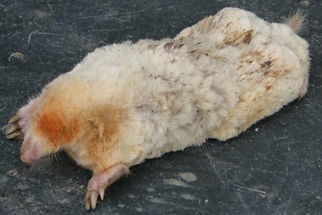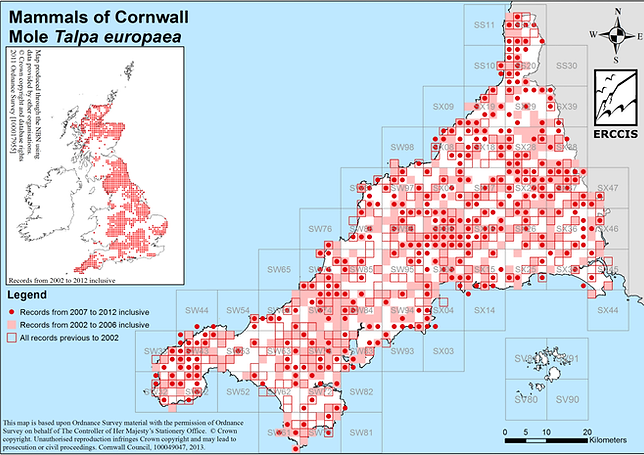
Mole -(Talpa europaea)
Order: Eulipotyphla, Cornish Name: Godh
Recognition:
Although moles are rarely seen above ground they are easily recognised by their short black velvety fur, their pointed snouts with tiny eyes and their massive front feet. Moles
are not infrequently found with albino, grey, ginger, or even piebald coats. Their feet and snouts lack fur. There are coarse hairs, called vibrissae, on the face, forelimbs and tail which help the mole sense its surroundings.
Moles are 113 to 159 mm long with a tail of 25 to 40 mm; adults weigh between 72 and 128 g. Males are generally slightly larger than females and there are few external
differences between the sexes. The mole is highly specialised for life underground and the front feet cannot be placed flat to the ground, the front paw includes an extra bone which acts as an additional digit and increases the surface area for digging. The bones of the front limb are massively developed to allow the attachment of strong muscles.
Tracks and Trails:
Molehills and shallow surface runs are pbvious signs of the presence of moles. In damp ground a large ‘fortress’ hill may be built which may contain a nest lined with dry leaves and grass. Moles are active all year round, alternating 4 hours of activity with a similar period of rest. Visible activity tends to increase during the breeding season between March and July when males are searching for mates, and again later in the year when the young disperse. Occasionally moles move above ground, especially during this dispersal, and their distinctive footprints may be seen in soft soil as they drag themselves forward. When above ground they are particularly vulnerable to predators and also to road traffic.

© Susan Morey
Moles are one of our commonest mammals and can be found in almost every habitat
where sufficient food is available. Molehills are easiest to see in open fields and
parkland but are also commonly found in woodland. They are generally scarcer in rocky mountains, sandy areas and in coniferous woodland. Moles are generally absent from very wet areas and from intensively urbanised areas. They build an extensive network of tunnels at different levels and patrol this regularly in search of prey which has burrowed into them.
Earthworms form the major part of the mole’s diet along with other insects which fall
into the tunnel system. Moles have also been recorded eating carrion, frogs and, in
Germany, truffles. Moles eat 70 to 100% of their bodyweight every day. In times of
plenty moles store earthworms, paralysing them by biting through the worm’s nervous system.
Moles typically live for about 3 years and they are solitary except for a very brief
courtship. The young (3 or 4 in the litter) are born in the spring, weaned after one
month and disperse soon afterwards. Moles are active night and day with 4 hour cycles of rest and feeding. They are highly territorial, not surprisingly since a large amount of time and energy is expended on digging and maintaining the tunnel network. Vacant territories are quickly occupied. Although territories vary in size depending on the habitat and availability of food, females typically occupy about 2000 m2 and males 50% more. During the breeding season males will tunnel over extensive areas in search of females, increasing their territory three-fold.
The mole has many enemies apart from man. Within their tunnels they are vulnerable
to badgers, foxes, weasels, and herons. Above ground they are also vulnerable to cats, owls, and other birds of prey.
Survey Methods:
Molehills and tunnels. Cat kills. Live sightings. Owl (and heron) pellets. Pest
controllers.
Although common, moles are rarely seen above ground and the disadvantage of unusual colours is probably insignificant. This golden mole was found in South Petherwin, near Launceston, in 2011.

© Jenny Lucas

Distribution:
Moles are widespread in Cornwall in suitable habitat. There are no records from the Isles of Scilly. It may be under-recorded in some areas, because of its sheer familiarity. Moles occur throughout lowland England wherever its major prey, the earthworm, is found, but they are not found in Ireland. They are found across central Europe and into Asia north of the Himalayas.
Records:
2007-2012: 931
2002-2007: 1863
Pre-2001: 983
Total: 3777
Did you know?:
The moles is also known as the
moldewarp or unt. Moles find their food and communicate mainly using touch. Their small eyes are probably only useful to discriminate light and dark. The mole has no external ears, but still has excellent hearing. Moleskin was traditionally used by plumbers to clean pipe joints before soldering. In 1702 King William III died from complications resulting from a fall when his horse tripped on a mole hill – afterwards his Jacobite enemies raised a toast to ‘the little gentleman in black velvet’.
Conservation:
Moles have no specific legal protection in the UK and are often regarded as pests by farmers and horticulturists. Molehills can cause problems by damaging machinery or by contaminating silage and causing listeriosis in sheep; animals may also hurt themselves by tripping in molehills or tunnels. Landowners use a variety of methods to control moles although the option of strychnine to poison them is no longer legal.



